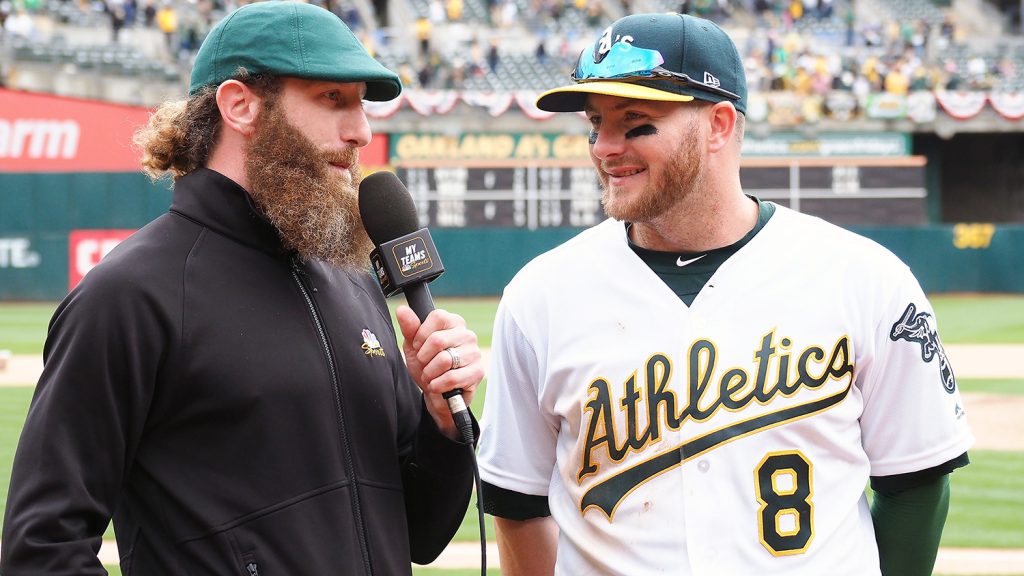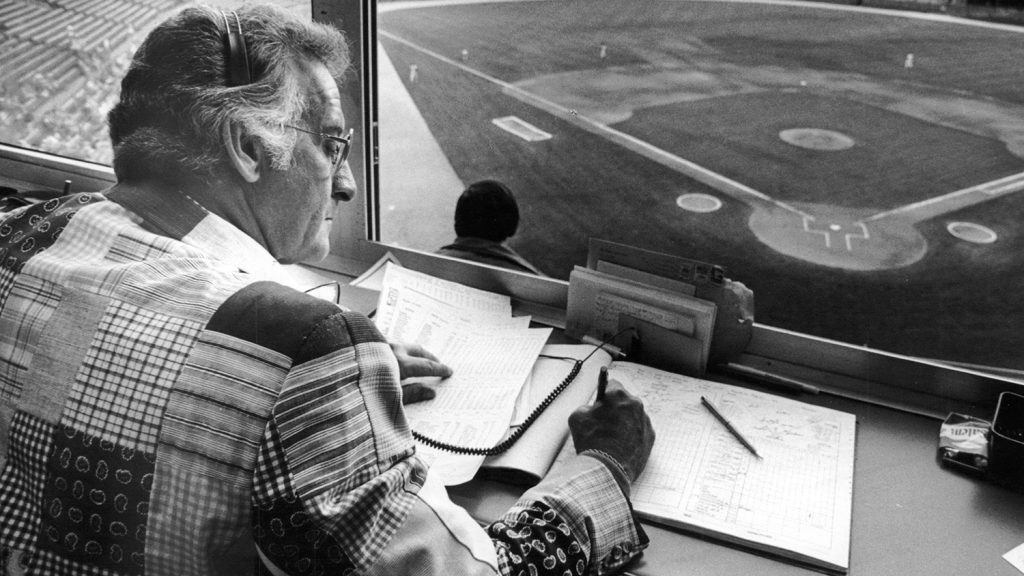
The Art of Commentating Baseball: The Voices Behind America’s Pastime
Baseball is like a story.
Every game, every inning, every at-bat and every pitch presents a new tale, a chapter in an athletic chronicle. And the ultimate voices who give life to these transcriptions and provide context to the masses are broadcasters.
“That’s why [baseball] is so special,” USF play-by-play broadcaster Ryan Urquhart said. “You get these interesting connections over time as a broadcaster with your audience. Because you’re spending so much downtime together, you get a sense of personality.”
Urquhart graduated from the University of Florida in 2020 and is the TV and radio voice of the USF Bulls for a variety of sports, including baseball. He also fills in for UF softball and baseball games.
“Storytelling is king,” he said. “Your ability to go out and form relationships and find stories and understand where to place them is so, so important to quality baseball broadcasting.”
What Urquhart speaks about makes a baseball game so interesting to watch on TV or listen to on the radio. It’s the optimum broadcasters’s forum. With the amount of time that there’s no action happening on the field, baseball announcers require an innate ability to entertain an audience for three hours 162 times each year. This is especially true when the game is all but over in the bottom of the ninth inning, and the closer is on the mound with the opposing team’s best hitter at the plate. Those unassuming moments require broadcasting precision.
Urquhart got his first chance to call a Florida baseball game on the Gators Sports Network from Learfield recently, and it required that he keep the broadcast interesting.
“That Florida-Vanderbilt game I did, that was, for me, a big career break,” he said. “I was so excited because I might get to call a cool Florida moment. They got shut out. Vanderbilt took a 6-0 lead. And I’m sitting there going ‘Great, now I have to kill three more innings, and figure out how to make this entertaining.’”
It was a great learning experience because he had to use his soft skills to keep the audience engaged throughout the rest of the broadcast. That meant diving into why the game mattered and providing an outlook on the remainder of the season. Urquhart also mentioned that he leaned on the color commentator to navigate the situation.

Relationships in the Booth
The relationship between a play-by-play announcer and their accompanying analyst, especially in baseball, is of the utmost importance. The rapport that partners build away from the game sometimes leads to the greatest moments during it.
“You can’t fake chemistry,” Athletics play-by-play broadcaster Chris Caray said. “If you don’t like each other, it’s going to come out on the air at one point or another … Going to dinners together, talking about things outside of baseball [is] really important so [your partner] can understand the type of person you are.”
Caray is someone who learned what it meant to be a high-level baseball broadcaster at a very young age. His great-grandfather, Harry Caray, was the legendary radio and TV voice of the St. Louis Cardinals and Chicago Cubs, among other teams, while his grandfather, Skip Caray, was the longtime announcer for the Atlanta Braves. The family history of phenomenal broadcasting is something that Chris doesn’t shy away from, but he said he wants to make a name for himself.
Caray is in his second season with the Athletics’ broadcast crew and splits play-by-play duties with Jenny Cavnar, who is the first woman to be the primary TV voice for a major league team. In 2022, he worked alongside his twin brother, Stefan, as the broadcaster for the Amarillo Sod Poodles, the Arizona Diamondbacks’ Double-A affiliate.
At just 25 years old, Caray is in a position that kids grow up dreaming of, and he doesn’t take it for granted. He said he works with his analysts to produce the best broadcast possible and learns from their experiences.
“The analyst is also really good at telling stories,” Caray said. “They’ve been a part of it. They’ve pitched in the big leagues, they’ve hit in the big leagues, they’ve talked to the legends, and they’ve had their own independent stories.”
Caray specifically mentioned working with Dallas Braden, who pitched for the A’s for five years, has been an incredible experience for him.
Behind-the-Scenes Preparation
While everyone remembers the big calls that happen throughout a season, the average fan may not understand the preparation that goes into a broadcast before the crew goes on the air. And while each broadcaster has their own voice, they also have their own way of preparing.
“I write everything in pencil,” Caray said. “Mine is all in my scorebook. Overpreparation is a real thing. You’re going to do 100% prep, and 90% of it might not get used. The story of the game is on the field.”
The old-school mentality that Caray uses may come from growing up around baseball savants, like those scattered throughout his family.

Urquhart’s style is much different and reliant on technology. He uses Microsoft OneNote and has a note page for both teams in each game. He also has a note page for each of the key players on the two teams, so he can easily find stats and storylines about the big-name players moment-by-moment.
Stats and numbers are a huge part of every sport. Baseball is no different. One announcer who is a self-proclaimed “stat wonk” is Mike Ferrin. The freelance play-by-play announcer has worked with the Diamondbacks and currently does radio work for Sirius XM and TV with ESPN.
Ferrin talked about how, while it is important to use numbers in a broadcast, it can become overbearing at times. Because of this, he likes to use the analytics in a different way.
“You need to know stats,” Ferrin said. “[But] I think they can bog down a broadcast, especially on the radio … [So] I like to talk about the concepts behind them, and I think those lead to good conversations. That’s the way I prepare.”
One True Love
A broadcaster can have all the stats in the world and the most heartfelt, in-depth stories imaginable, but if he or she doesn’t have a great passion for the game of baseball, they won’t produce an entertaining broadcast. There needs to be a love of the sport and a willingness to go back in the booth day after day.
Ferrin fell in love with baseball at a young age. He said he knew as early as his T-ball days that he wasn’t going to play professionally, so he wanted to carve his own path to stay with the game he adored.
“I love baseball,” Ferrin said. “It’s my favorite sport. I’m obsessed with learning about it even though I know I’ll never conquer it. That was a big reason why I wanted to do it. I loved it.”
For decades, baseball has been the premier sport for a broadcaster to thrive. Names like Vin Scully, Bob Uecker and Red Barber paved the way for the next generation of great broadcasters to prosper. Baseball broadcasting is an art form, and the artists who make magic happen over the airwaves are the play-by-play announcers.
More CJCxARZ Spring Training Coverage:
* The Unconventional Angle: The Rare Commodity, Craft of Baseball’s Sidearm Pitchers
* The Importance of Spring Training: How it Shapes Players of All Levels
* More Than Words: Inside the Important, Unique — And Sometimes Random — Role of MLB Translators
* Man vs. Machine: MLB’s Automated Ball-Strike Spring Experiment Shows Game’s Evolution
Category: Athletics, Chicago Cubs, Milwaukee Brewers, Seattle Mariners, Top Stories
Tagged: Bob Uecker Broadcasting Chris Caray Mike Ferrin MLB MLB broadcasting MLB Spring Training Red Barber Ryan Urquhart Spring Training Vin Scully


